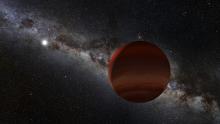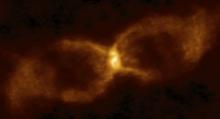Listen to today's episode of StarDate on the web the same day it airs in high-quality streaming audio without any extra ads or announcements. Choose a $8 one-month pass, or listen every day for a year for just $30.
You are here
Moon and Jupiter
If the night sky was a TV show, tonight’s episode might be called Luna and the Giant. That’s because the Moon has a big companion tonight — the planet Jupiter. It looks like a brilliant star quite close to the left or lower left of the Moon.
Jupiter is the biggest planet in the solar system — about 11 times the diameter of Earth. As astronomers look around the galaxy, though, they find that Jupiter’s size is quite popular.
Hundreds of planets found in other star systems are about the same size as Jupiter, even though many of them are a good bit heavier.
Jupiter is also about the same size as the typical brown dwarf — an object that’s more massive than a planet, but not massive enough to shine as a star. And it’s close to the size of the smallest stars. At a minimum, these stars are about 80 times the mass of Jupiter. But the least massive are actually smaller than Jupiter.
All of these objects are about the same size because of gravity. If you add more material to an object the mass of Jupiter, it doesn’t get much bigger because gravity squeezes it more tightly.
Once a star reaches a certain critical mass, though, it starts to get bigger in a hurry. For one thing, there’s just too much stuff to pack into a smaller space. More important, though, is that the core of a star generates nuclear energy, which pushes outward on the gas around it. That causes the star to get bigger — pushing it out of the realm of “Jupiter-sized.”
Script by Damond Benningfield





